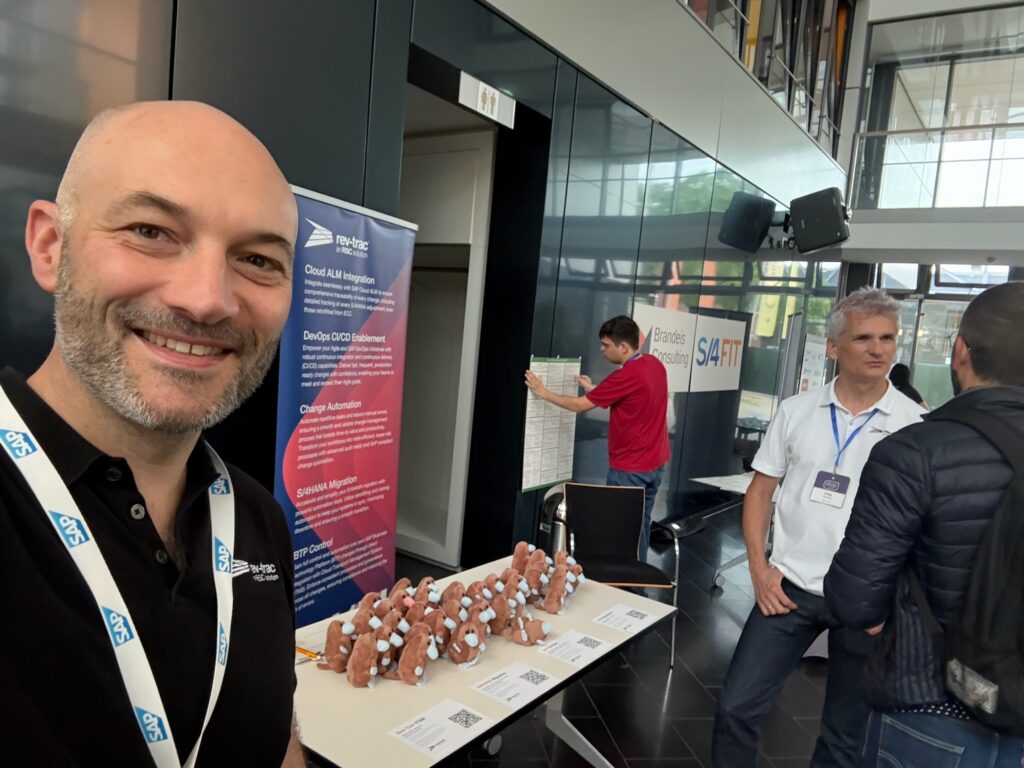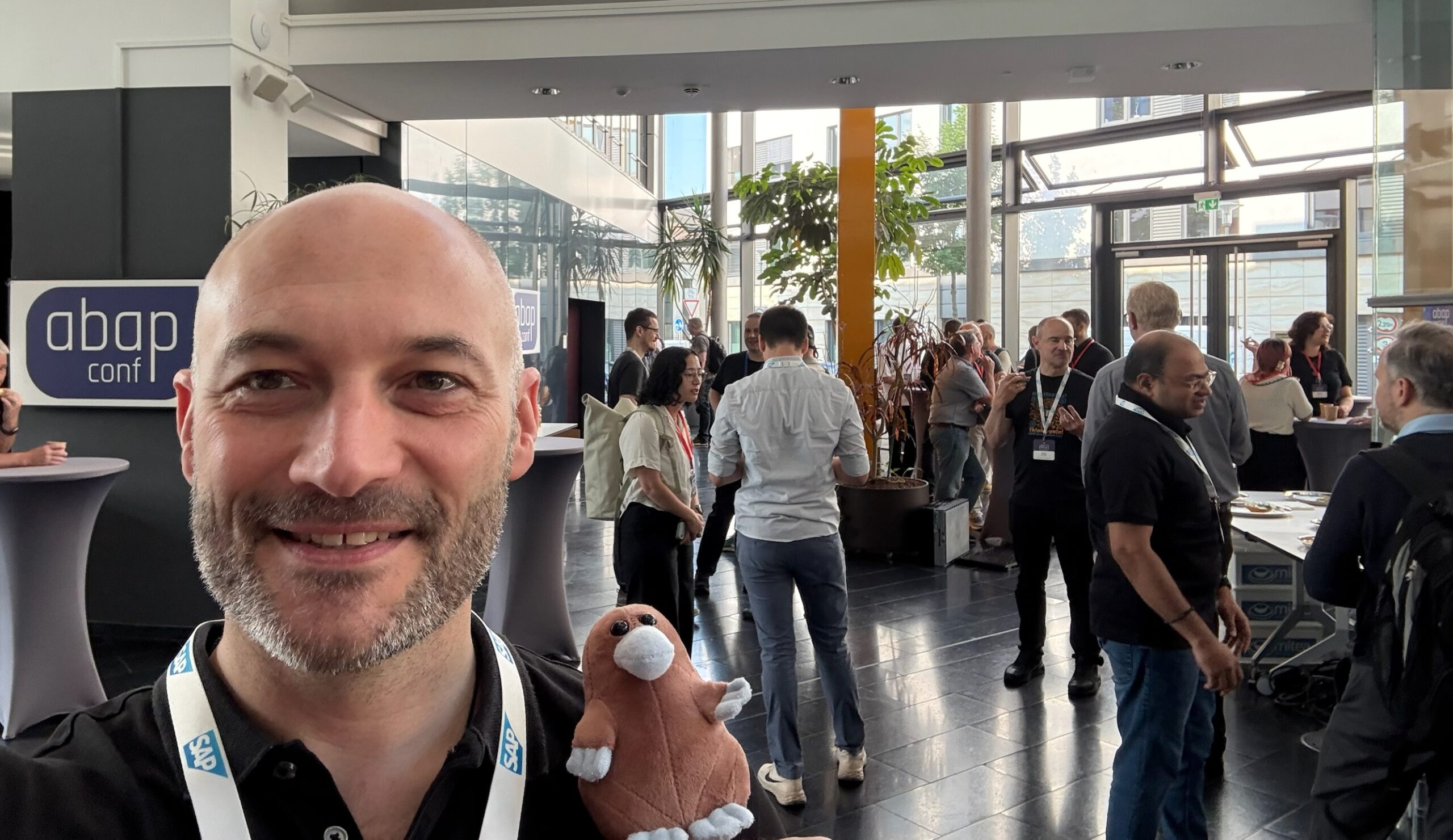TL;DR
- ABAPConf was a full-scale event this year, running simultaneously at four sites, both online and onsite.
- The event itself was insightful, interactive, and engaging.
- Great talks were presented, some from experience, some from SAP implementation teams, with thoughtful questions and discussion.
Introduction
ABAPConf 2025 was full-on, with four locations running simultaneously over two days, taking the ABAP-focused conference for developers, by developers, to the next level. Rev-Trac again had the privilege of supporting ABAPConf, building on last year’s participation at Code Connect in St. Leon-Rot alongside recap and UI5Con. I was fortunate enough to attend onsite at Mannheim with colleagues, which, in my view, is the best way to experience this type of event.
Community Day
Community Day set the tone for the conference, offering a cozy space to connect over beer and pizza. I also had the pleasure of presenting with my colleague Fritz Mosonyi, where we shared tips on “shifting left” in S/4HANA transformations, delivered as a fanciful fairytale to highlight key takeaways around preparation and culture. Fritz followed up with a createive board game showcasing how Rev-Trac supports successful migrations.
We also heard from Tobias Hoffman on some very interesting statistics about the usage of SAP and ABAP compared to other languages and ecosystems. Another interesting point was the distinction regarding why there are such big differences and that the nature of the sector, with its need for stable transactions, is a big part of it.
Laura Schmitz from the SAP Community advocacy group shared all the things that are being done to support the community, including the encouragement of location groups that run grassroots community events, like this one.
Day 1: June 4, 2025
We kicked off with the intro and the first talk on the Capabilities of SAP and ABAP from Tobias Hoffman and Paul Peitz. This dug into the challenges faced when going from traditional ABAP to the modern landscape we find ourselves in today.
I felt the audience was unanimous in the feeling that the vast array of options and components required to build a solution now is huge compared to when there was just classic ABAP, Dnypro and ABAP SQL, resulting in quicker time to value and less moving parts. Now, there are various extension options, technology layers and challenges to get things up and running. Not to mention the choice of IDE’s (and the need for both ADT and BAS to develop a full app) and the complexity of integration. Add to that debugging or tracing the various stacks and the challenge of the training gap.
On the positive side, the new AI capabilities were raised as something that adds promise in this area. There were some very valid points raised here, and the fundamental architecture has added some fundamental complexity to the solutions we deliver now. My only conjecture regarding this sentiment is that while we may romanticize the simpler days of classic ABAP, the past had its own jungle of technologies and frameworks — BSPs, WDA, PI/PO, BW/BEx, LSMWs, Workflows, Processes and forms, Visual Composer etc. Every era has its complexity; it just changes shape. Overall, this was a great, thought-provoking discussion starter.
Next, I caught a Labs Preview demo of Joule generating a full RAP application based on a hand–drawn specification with Christoph Gollmick and Sebastian Werner. It was interesting to see such progress, but there is still some work to be done for it to have full maturity.
Archish Ruppa from Swiss Rail (SBB) shared the experience of their ECC to S/4HANA transformation journey. Diving into two specific examples of apps they had re-implemented in RAP and how they managed to achieve a clean core rating of around 90% and 80% for each, respectively. It was encouraging to see and to hear about the real-world challenges they faced such as the difficulty in where to find released objects, and that there is currently no support for lock objects.
The next talk was by Björn Schulz (from Software Heroes) on the XCO library, which is the released extension components library. This is a standard set of classes that provide framework– level tooling for functionalities such as Date/Time, system runtime information, Json, Excel, UUID, String and Messages, all done with a nicely fluent API.
Some people I spoke to did not rate this topic highly, but for me, it was a gem. These are the things I had wished for in ABAP since I had become proficient. In so many places, I would have to implement my own message objects and then convince incumbents of the benefits. There was so much confusion and re-work. But now we have a library and one for various scopes of release (standard, Cloud, and key user).
The demonstration showcased the object generation capabilities, which was helpful, but on the downside, the audience did get a little side–tracked on the intricacies of dynamic code generation. So, for me, the XCO libraries were great to get awareness of, but they had one major shortcoming regarding testability. All the factory methods are static, which adds back in some of the work that has been saved by this.

Day 2: June 5, 2025
The second day started with an overview of the impact and strategy of the ABAP platform from Boris Gebhardt and Fabian Fellhauer. It covered how ABAP Cloud can be used on all stacks, from on prem to public Cloud (given you’re on the right version). From a roadmap perspective, currently, there is the RAP Business Object Generator as well as Joule Dev Capabilities for ABAP. Next, support for static draft scope and collaborative drafts. Soon, analytic table with aggregation and grouping and AI user input recommendations. We also got a demo of some of that AI capability, generating a managed RAP and implementing a validation, to a limited extent.
CDS RAP Fiori Elements was the next topic by Frank Engert from Softway. This was another excellent showcase of some real-world usage, and this one was for BTP ABAP Multitenant SaaS. A very interesting topic thoroughly explained. As well as sharing the challenges faced. The scenario involved an e-invoicing that plugged in easily to on premise systems via Cloud Connector, with iDocs pushing the invoice data out. Frank gave a thorough overview of the solution, the implications of multitenancy and the learning journey to upskill the ABAP team.
He explained the benefit of the open– source RAP Generator by André Fischer for more complex RAP App scenarios such as this one, and some handy tips such as doing some sample runs before the good version. The other RAP APP Generator tools for business maintenance configuration and multidimensional analysis were also used with good results. The challenges were also shared, including the lack of data– driven automated unit testing that tools such as eCATT Test Data Containers once provided. Frank then took some questions on his area of expertise regarding output management.
After lunch, we were treated to a deep dive into the mind of Joule for ABAP by Sevdiye Linnhoff, Leon Knorr and Manuel Berning. The feature code explain was explained very nicely by Sevdiye and introduced how the AI model is quality controlled and measured against other models as they hone it. Manuel explained how predictive code completion works and provided more insight again into how the models were being constantly trained and refined based on benchmarks of competing models, switching out to them if they win. He said that using HumanEval benchmark the ABAP AI is at about 80% compared to Python currently at 94%, giving a good indication of the progress made and yet to go.
Leon then goes further under the hood, explaining the AI model is combined with the developer contexts (local code, dependencies, comments, unit tests, etc.) at runtime to provide useful and relevant results, all while keeping your IP secure. The challenges of making this performant were discussed, along with an overview of a new approach to improve by bringing these processes closer together.
Clément Ringot demonstrated an example of extending an API with ABAP Cloud with a new persisted field. It was great to see a real live demo of this.
Joshua Heisler provided an insightful presentation on navigating the maze that is extending S/4HANA (on prem). The SAP BTP Guidance Framework is useful for this, and the SAP Application Extension Methodology has a handy spreadsheet! There are also some good documents, including:
- Extend SAP S/4HANA in the cloud and on premise ABAP based extensions
- ABAP Cloud API Enablement Guidelines for SAP S/HANA Cloud, private edition, and SAP S/HANA
- ABAP Cloud Technical use cases and recommended technologies
Joshua also shared an interesting way that he further refined the Application Extension Methodology into a usable decision framework that assessed requirements from an Architectural, Conceptual and Actual perspective to find the best approach. He also shared a very interesting open-source project, the extension inspector, which exposes all the components, dependencies, and relationships of extension code.
Lastly, Markus Koenigstein from SAP shared some of the latest innovations for ABAP Odata V4 Fiori Elements with the 2508 ABAP feature updates:
- Side effect events providing real time backend updates for Fiori Elements via web sockets which is now coming to private editions. This was nice, and I am feeling jealous for CAP on this one.
- The ability to have Analytical tables within object pages (read only) with grouping and totals.
- Markus also shared the next–generation Flexible Programming Model Explorer – very exciting to see, and I’m looking forward to this for both RAP and CAP.
- We also got to see the latest Key User adaption. It is now possible to update field labels and change text arrangement for fields on standard apps.
- There is also a feature to allow you to see all shortcuts, contextually for a Fiori Elements application via the user menu of the application bar.
- Also, now the context help show the Data Dictionary help from the backend.
Everyone wound up very satisfied with having a fantastic array of valuable information on the latest and greatest ABAP advancements. And even though there was the usual dose of AI, it was not just pithy marketing overviews but real demos or behind the scenes details. As always, getting to interact with like-minded developers in the community made the whole event a complete winner.
ABAPConf 2025 once again proved how vibrant, collaborative, and forward-thinking the SAP developer community is. Whether you were there onsite or joining online, the insights shared, and connections made will help maintain the vibrancy in the ABAP community.

